The Search for Home, Truly (and Other National Day Songs)
The effort to find songs that express a national identity goes back to the 1970s.
By Bernard T.G. Tan
Dick Lee’s “Home” is arguably one of the most well loved of all our National Day songs. While the song is indelibly associated with the voice of Kit Chan, who performed it at the National Day Parade (NDP) in 1998, it is also a song that is regularly sung in unison at subsequent NDPs.
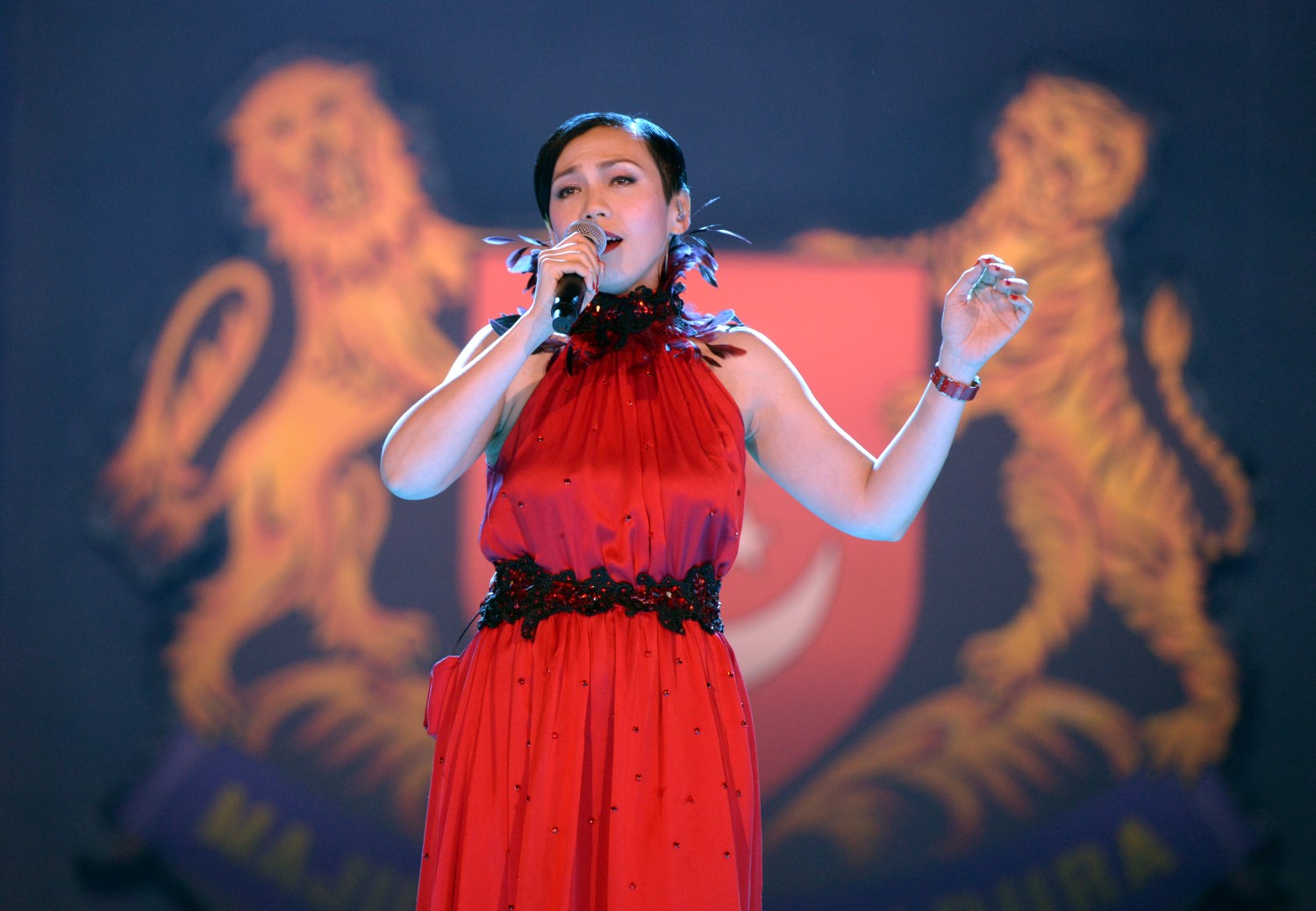 Kit Chan performing “Home” at the National Day Parade preview on 1 August 2015. Source: The Straits Times © SPH Media Limited. Permission required for reproduction.
Kit Chan performing “Home” at the National Day Parade preview on 1 August 2015. Source: The Straits Times © SPH Media Limited. Permission required for reproduction.The popularity of National Day songs like “Home” and “Stand Up for Singapore” is the result of a decades-long effort to create national songs that can be sung communally. This effort to find a song that represents the nation (apart from “Majulah Singapura”, the national anthem) goes back at least to the 1970s.
The Early Years
In 1975, the National Theatre Trust and Radio and Television Singapore launched a nationwide songwriting competition named “Our Songs”.1 Eight winners were chosen from the 51 entries, with music teacher Mary Tan’s “A Pretty Island” winning the top prize at the concert on 4 May 1975. Some of the song entries which are still sung today include “The Fair Shore of Singapore” by Oon Siew Lian, “Sing a Song of Singapore” by Samuel Liew and “Selamat Datang ke-Singapura” by Rudy Mosbergen.
The second competition in 1976 had a lyric writing competition followed by a songwriting competition using the winning lyrics.2 A total of 206 song lyrics in the four official languages were received, and three entries from each language were chosen for the songwriting competition launched in January 1977. The winning entry at the grand finals of the competition on 11 June that year was “Salute to Singapore” by Alex Abisheganaden (who would be conferred the Cultural Medallion in 1988). The third competition was launched in 1978 and had its grand finals on 31 May 1979. The winners were “It’s National Day”, “Mooncake Festival” and “City of Lights” (in English), “Happy New Year” and “Celebrating New Year” (in Chinese), “Sangeduthu Oothuvolam” (in Tamil) and “Gembira Di Hari Raya” and “Pesta Hari Nasional” (in Malay).3
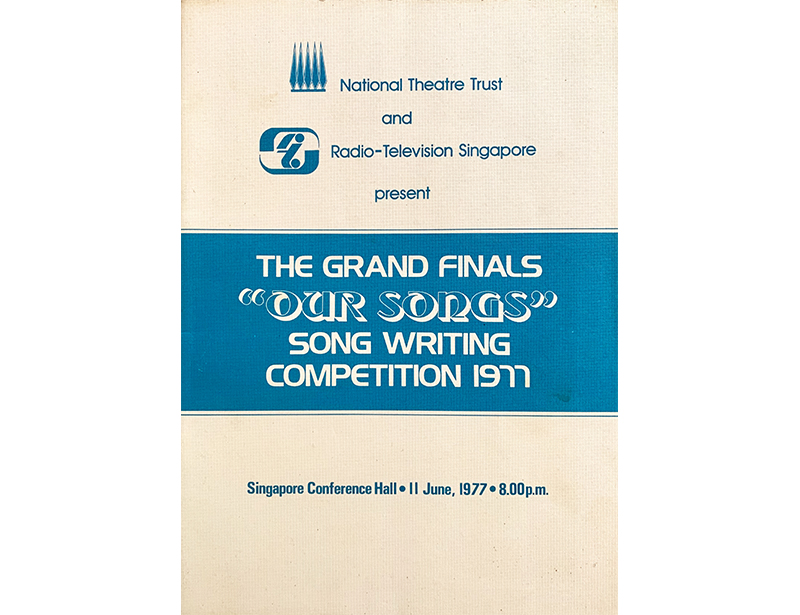
In 1979, the organisers invited seven composers and six poets to write Singapore songs. As the lyrics were written in Chinese (no English writers and poets responded to the project), the songs composed were in Chinese. Thirteen songs were showcased at the “Our Songs” concert on 15 March 1980, featuring composers Leong Yoon Pin, Samuel Ting, Goh Say Meng, Lee Tack Fah, Lim Tiap Guan, Sim Peng Kwang and Kam Kee Yong. This was followed by a second concert on 28 June with 12 songs. Some of the featured Singapore composers in this second concert were Shen Ping Kwang, Kam Kee Yong, Lim Tiap Guan, Lee Tack Fah, Samuel Ting, Leong Yoon Pin and Goh Say Meng.4
A third presentation of 17 songs on 22 February 1981 was organised under the banner of the Singapore Composers’ Circle, which was founded in July 1980 by the National Theatre Trust.5 The new composers featured in this third concert were Chiew Keng Hoon, Chuang Heng Siong, Quek Yong Siu, Lee Yuk Chuan and Lee Kian Long.6 Some of the choirs which performed regularly in this series include the Heralds Choral Society, the Young Voices Choir and the Mellow Art Choir.
Around this time, there was an attempt to turn the song “Singapura” into a national song. This song – popularised by the Dutch-Indonesian singer Anneke Gronloh in the early 1960s – had been adapted from an Indonesian tune and was sung originally in Malay. In 1980, a new version of the song was suddenly promoted on primetime TV. This new version used the same melody but had new lyrics in English. A Straits Times report cited sources saying that the national broadcaster was “playing the role of ‘pied piper of Singapore’ on the suggestion of the Ministry of Culture to find a series of local songs in Malay, Chinese and English that Singaporeans can call their own”. The report added that Singapore’s quest for national songs was a follow-up to an effort to find a national dress for men and women that had been initiated by the Ministry of Culture in April 1980.7
“Songs of Singapore”
The quest to find national songs gathered momentum in the early 1980s. In 1981, the Ministry of Culture began to form a committee to look for locally written and composed songs in an initiative funded by the Singapore Cultural Foundation.8 This search for new national songs, dubbed the “Songs of Singapore” project, was launched in March 1982 by Culture Ministry parliamentary secretary Wan Hussin Zoohri. “Singaporeans must sing more spontaneously and frequently to develop that sense of camaraderie so integral to unity and nationhood,” he told the Straits Times. Another reason he gave was that there was “a need for some Singapore songs which Singaporeans may sing with confidence at international and regional gatherings”.9
This hinted at one of the driving forces behind this new national song effort. Apparently, whenever delegates were asked to showcase something from their own culture at international meetings and conferences, the Singapore delegation invariably ending up singing either the now rather tired “Singapura” or even the national anthem, “Majulah Singapura”. Ministers and senior civil servants strongly believed that something had to be done to create more Singapore songs that they could sing at these events.
The campaign was run by a new “Songs of Singapore” committee eventually formed in early 1982 and chaired by me. In January 1983, the committee announced that the best songs would be picked by a public popularity poll sometime in the middle of 1983.10 “[T]he committee believes that if these are to be songs of Singapore, then they must be songs Singaporeans like,” the Straits Times reported.11
By “scouring army camps, junior colleges, community and youth groups, university halls of residence, among other places for more songs”, the committee was able to collect more than a thousand songs during the “Songs of Singapore” campaign. The committee was not concerned about the artistic quality or the musical idiom, but simply wanted songs written spontaneously by the man in the street, which would appeal to the average Singaporean.12
While public enthusiasm was high, songwriting skills were then at a fairly rudimentary stage and I cannot recall any songs collected which eventually made it to the national pantheon of songs. However, the campaign did fulfill its objective of arousing interest in songs that Singaporeans could call their own, and songwriting skills did indeed improve eventually.
Commissioned National Day Songs
By the mid-1980s, the search for national songs began to shift to a higher gear. Singapore had attained self-governance in 1959, which meant that 1984 was the 25th anniversary of that important milestone. As a result, the authorities were anxious to find a suitable song to mark the occasion. Richard Tan, the deputy director of the Psychological Defence Division in the Ministry of Communications and Information, drove the effort.13
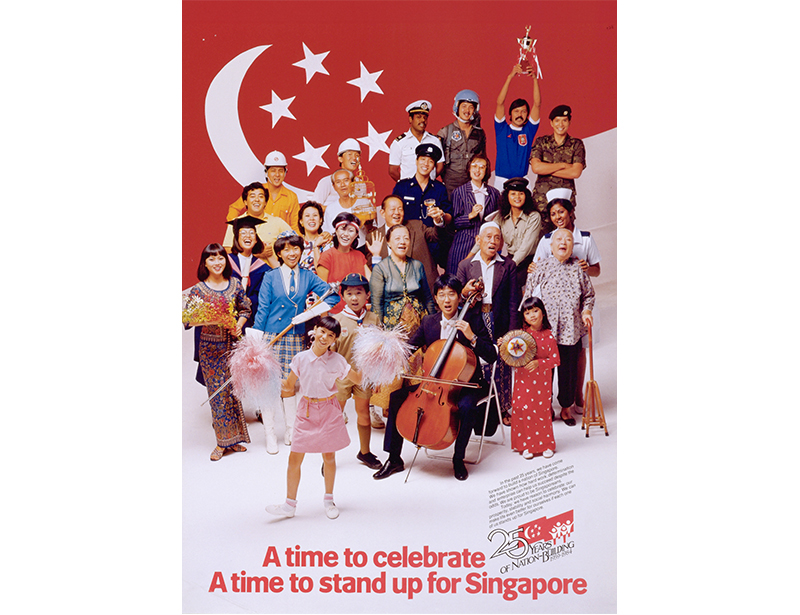
The ministry put out a tender which was won by ad agency McCann Erickson and out of it came one of our most popular national songs, “Stand Up for Singapore”, which became the 1984 NDP theme song.14 It was not revealed at the time, though, that the lyricist and composer of the song was Hugh Harrison, a Canadian, who had been commissioned by the ad agency.15
Two years later, Tan led the search for a successor to “Stand Up for Singapore”. The next song chosen, “Count on Me, Singapore”, also by Harrison, became the NDP song in 1986.16 Harrison’s third song, “We Are Singapore”, was selected for NDP 1987.17 All three songs by Harrison have since become solid favourites of Singaporeans and are regularly featured at various NDPs.
“Sing Singapore”
By the late 1980s, the focus shifted briefly to the promotion of community singing of the existing repertoire. In January 1988, a new national programme called Sing Singapore was launched to “promote community singing as a way of life in Singapore”. A songbook and a set of two cassette tapes containing 48 songs in English, Malay, Mandarin and Tamil were issued. The songs included earlier National Day songs as well as old favourites such as “Di-Tanjong Katong”. The inaugural Sing Singapore was launched with a concert on 30 January 1988 on the steps of City Hall.18
Tan told the Straits Times that it was important to gather more songs and create and establish more opportunities for community singing. “We hope that by August, people will be able to sing at least 10 of the songs and we’ll have a singing National Stadium on National Day,” he added.19
Driving the programme was the newly established Sing Singapore committee, which consisted of representatives from the public and private sectors. They included the ministries of communications and information, community development, defence, education and home affairs; the Singapore Armed Forces; the People’s Association; the Singapore Broadcasting Corporation; Fraser & Neave; and Singapore Press Holdings.20
The campaign incorporated a national community singing contest organised by the Ministry of Community Development to showcase the national songs being promoted.21 In addition to schools and the private sector, there was an enthusiastic response from the public sector and some 2,300 civil servants formed 60 singing groups to take part. The grand finals took place on 23 July 1988.22
The five public sector teams that made it to the grand finals were BG Melody (from the Parks and Recreation Department), Fantastic Force (from the Police), MAS Voices (from the Monetary Authority of Singapore), Sweet Melodies (from the Singapore Armed Forces) and Telechords (from the Telecommunications Authority).23 In the end, the Fantastic Force won the first prize in the public sector category and the overall challenge trophy.24
The entire campaign came to a rousing end on 31 August 1988 at the National Stadium. On that same evening, “Majulah Singapura” was performed by the Singapore Symphony Orchestra and Chorus in a “new, richer and grander arrangement”. At the event, Communications and Information Minister Yeo Ning Hong noted that more than 524 groups comprising over 16,000 participants had taken part in Sing Singapore.25
The next edition of Sing Singapore was launched at the National Stadium on 29 December 1989.26 As 1990 was the 25th anniversary of Singapore’s independence, a new national song, “One People, One Nation, One Singapore”, was commissioned, with lyrics by Australian Jim Aitchison and music by Singaporean composer Jeremy Monteiro.
The 1990 Sing Singapore competition was held on 21 July at the Indoor Stadium, and songbooks and music cassettes were produced for sale to the public.27 By this time, Sing Singapore had become more of a performance-oriented contest rather than a songwriting campaign, with the accent on encouraging community singing. In 1992, the competition returned to the Kallang Theatre, with the top prizes being won by the NUS Kent Ridge Alumni Singers.28
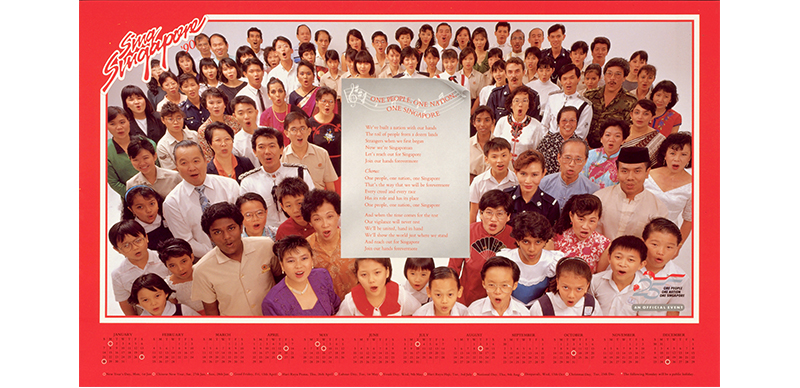
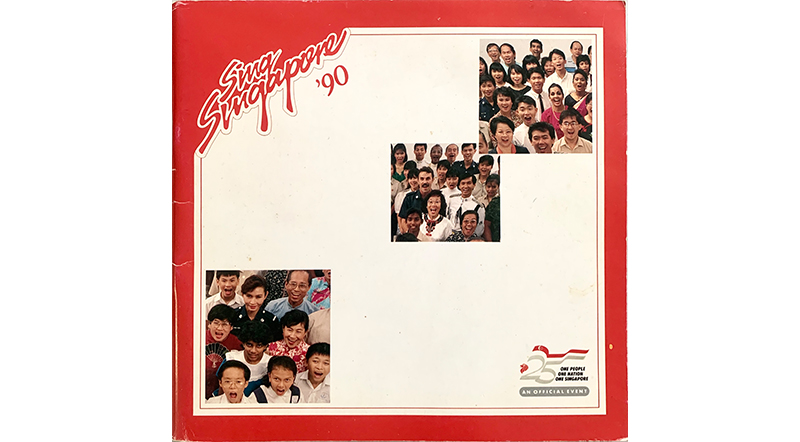
An initiative by NTUC Income in 1991 led to the national song, “It’s the Little Things”, by Patrick Seet and Ivan Chua.29
After the National Arts Council (NAC) was established in 1991, the new body took over the responsibility for the campaign. In 1993, the NAC brought back the creation and collection of Singapore songs into Sing Singapore. It also came up with a new branding – A Festival of Songs – for the 1994 campaign. In October 1993, the NAC invited Singaporeans to submit original songs. It attracted 48 groups that performed at the Ngee Ann City Civic Plaza in May and June the next year.30 The 1996 competition was called Song Fest, a catchier version of A Festival of Songs.31 Between 1991 and 1998, there seems to have been no new songs meant for National Day though.
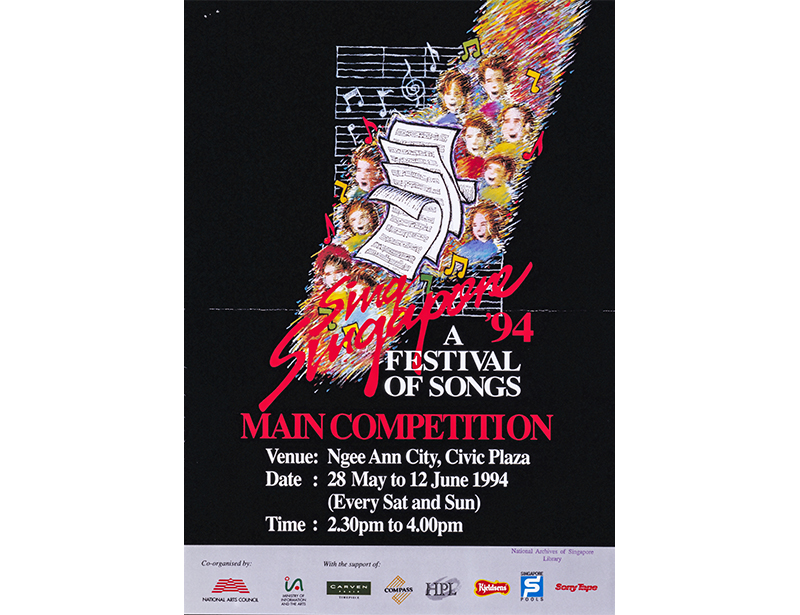
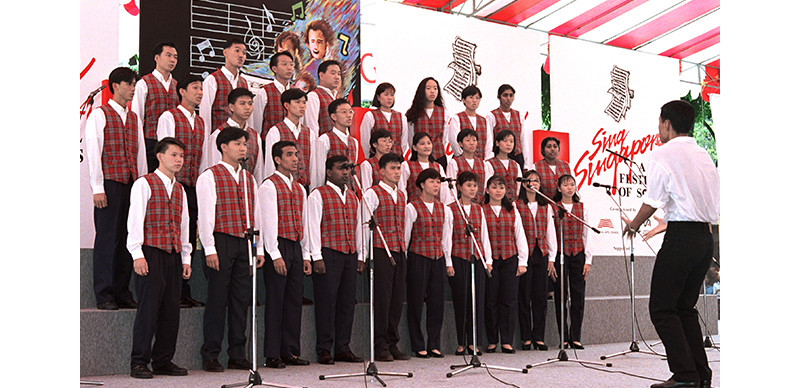
It was around this time that I was appointed chairman of the Sing Singapore organising committee. One of the new committee’s first tasks was to find a National Day song for 1998.32 Instead of holding an open competition, we approached a number of established Singaporean songwriters and composers to submit songs for our consideration.33 Dick Lee was among those who responded, but unlike the others, he submitted a melody without lyrics.
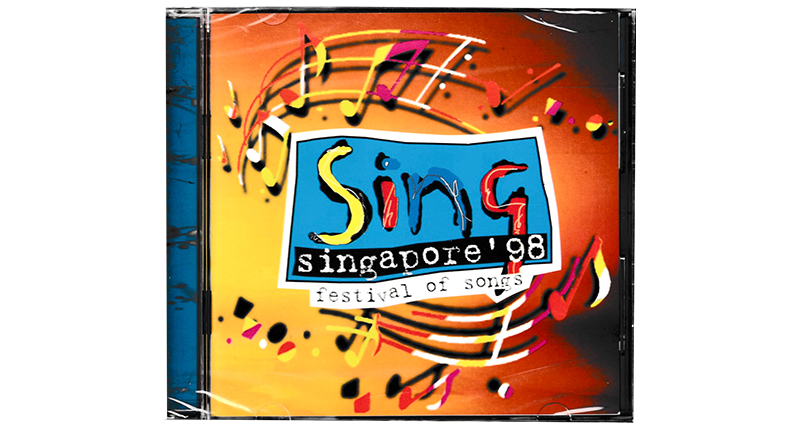
This Is Home, Truly
To understand how “Home” came about, we need to step back to look at Singapore that year. In 1998, the national mood in Singapore was not a happy one. The collapse of the Thai baht in July 1997 had plunged the region into the Asian financial crisis. In December 1997, the crash of a SilkAir plane in Indonesia deepened the gloom. We in the Sing Singapore committee realised that an upbeat National Day song in 1998 would be severely out of touch with the prevailing national mood.
None of the songs which had been submitted was quite what we were looking for. However, the melody Dick had submitted was certainly not “rah-rah” or upbeat, but lyrical and pensive in nature. We requested he add lyrics to his melody and suggested some themes he could work with.
Dick wrote one verse based on the notion of Singapore as “our home”, but we needed a second verse to make a complete song. After he had added the new verse, we felt that it needed a bit of tweaking, I called him in Hong Kong, where he was then based, and over this phone conversation, the second verse was finalised and “Home” was born.
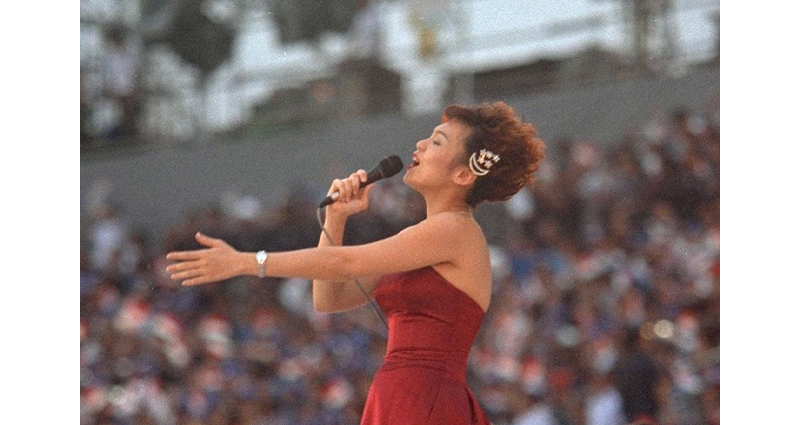
Although the committee knew that Dick had produced an outstanding song in consonance with the national mood, we wondered if the song’s slow tempo would be acceptable to the NDP organisers. I made a simple choral arrangement of the song and pitched it to the NDP committee, explaining why the song was not the usual upbeat “rah-rah” song. The committee immediately understood and readily agreed that “Home” would be the National Day song for 1998.
The musical arrangement for “Home” was placed in the very capable hands of Sydney Tan, and the choice of Kit Chan to sing it was an inspired one. They made a memorable recording of the song, which was immediately embraced and warmly received by Singaporeans. Since then, “Home” has become a permanent feature of all subsequent National Day celebrations. Kit has even adopted the song as a personal theme song, often singing it at her concerts. Other local singers such as JJ Lin and pop group The Sam Willows have put their spin on the song.34
The song has also been performed by foreign artists during their concerts in Singapore. In April 2024, at American pop star Bruno Mars’ concert, the audience started singing to “Home” when one of the singer’s band members, musician John Fossitt, played an instrumental rendition of the song during his keyboard solo. More recently, in July 2024, South Korean artist Solar (the leader and vocalist of girl group Mamamoo and its sub-unit Mamamoo+) sang “Home” at her concert.35
It should be mentioned that for 1998, there appears to have been two other National Day songs: “My People, My Home” with lyrics by Cultural Medallion poet Lee Tzu Pheng and music by Phoon Yew Tien, and “City for the World” by Roger Jenkins (lyrics) and Iskandar Ismail (music).36
While “Home” was a very hard act to follow, the two subsequent National Day songs – “Together” by Ken Lim for 1999 and “Shine on Me” by Jim Lim for 2000 – were creditable efforts. In 2001, singer-songwriter Tanya Chua’s “Where I Belong” was the National Day song and it quickly became a firm favourite of many Singaporeans. The following year, another song written and composed by Dick, “We Will Get There”, and sung by Stefanie Sun, became another much-loved National Day song and is my personal favourite National Day song.
In 2003, the Sing Singapore committee selected its last National Day song – “One United People” by Joshua Wan – which was sung by Stefanie Sun. I decided to step down from the committee soon after, and as it turned out, the committee was subsequently disbanded.37 The responsibility for National Day songs was then passed on to the National Day organisers themselves.
Looking back, I believe the Sing Singapore committee can take pride in the fact that it had fulfilled its duties, having produced some landmark and beloved songs that resonated with Singaporeans like “Home”, “Where I Belong” and “We Will Get There”.
After 2003 and the Pandemic
The National Day songs since 2003 have varied in style and genre as well in their reception by the general public. I particularly like Dick’s song, “Our Singapore”, for the nation’s 50th anniversary of independence in 2015, with its signature wordless refrain. The 2009 NDP song, “What Do You See?”, by the indie rock band Electrico might not have been everyone’s cup of tea, but it was musically interesting and well performed. It is one of the few NDP theme songs that do not have the word “Singapore” in its lyrics.
In 2020, the Covid-19 pandemic shut down Singapore and most of the world, and as a result, a new form of musical performance took shape – the Zoom performance – where musicians recorded their own parts separately which were then combined into a single performance.
In June 2020, as the circuit breaker was lifted, singer Joanna Dong – with members of the Singapore Symphony Chorus, Youth and Children’s Choir as well as musicians from the Singapore Symphony Orchestra – recorded Dick Lee’s “We Will Get There” from home. The version featured a highly effective arrangement by Gabriel Hoe and the performance undoubtedly helped to raise the spirits of Singaporeans during the dark days of the pandemic.38
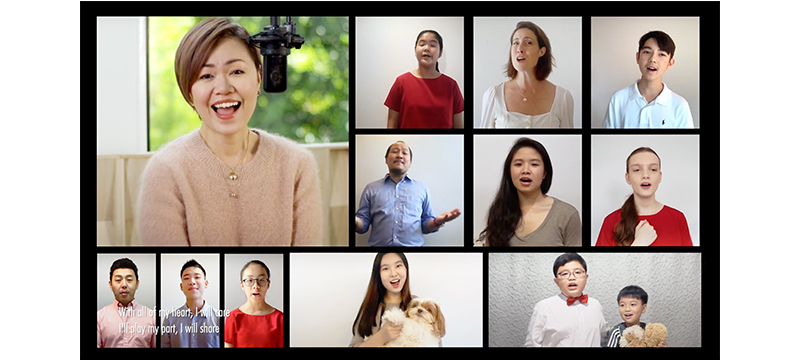
Post-pandemic, my favourite NDP song is “The Road Ahead” by singer-songwriter Linying in 2021. The song looks beyond the dark days of the pandemic to a brighter future.39
An Appeal
The selectors of National Day songs have the difficult and near-impossible task of choosing songs that not only encapsulate the hopes and dreams of a nation, but at the same time also cater to the musical tastes of every citizen. It is certainly not easy to compose a song that reflects the mood of a nation and musically appeals to the majority of the population.
I would therefore appeal to Singaporeans to receive each new National Day song with open minds and show much appreciation for the hard work put in by the composers, lyricists, singers, musicians, arrangers and producers in creating the song and making it accessible to everyone. Please listen to each new National Day song with receptive ears and spare a thought for the tremendous efforts that have gone into bringing the song to you.
 Emeritus Professor Bernard T.G. Tan is a retired professor of physics from the National University of Singapore who also dabbles in music. Some of his compositions have been performed by the Singapore Symphony Orchestra. He is a former chairman of the Sing Singapore organising committee.
Emeritus Professor Bernard T.G. Tan is a retired professor of physics from the National University of Singapore who also dabbles in music. Some of his compositions have been performed by the Singapore Symphony Orchestra. He is a former chairman of the Sing Singapore organising committee.NOTES
-
“Mary’s Solo Effort Hits the Top Note,” Straits Times, 6 May 1975, 13. (From NewspaperSG) ↩
-
“20 for Song Writing Contest,” New Nation, 1 June 1977, 3. (From NewspaperSG) ↩
-
Judith Holmberg, “‘Put the Sing into S’pore’ N-Day Shows,” New Nation, 30 July 1979, 19. (From NewspaperSG) ↩
-
“13 Pool Talents to Write Songs on S’pore,” Straits Times, 5 September 1979, 7; “28 Chinese Songs Given Music Scores,” Straits Times, 3 December 1979, 7; “12 More of Our Songs to Keep in Tune With,” Straits Times, 15 June 1980, 11. (From NewspaperSG) ↩
-
Khng Eu Meng, “Composers’ Circle Holds Its Third Presentation of Local Works,” New Nation, 30 January 1981, 12–13. (From NewspaperSG) ↩
-
“Debut of 17 Chinese Songs,” New Nation, 17 February 1981, 23. (From NewspaperSG) ↩
-
Cynthia Wee, “‘Singapura’ to Be One of Our National Songs?” Straits Times, 23 May 1980, 1. (From NewspaperSG) ↩
-
Bridget Tan, “Quest for Old Local Hit Songs,” Straits Times, 17 November 1981, 36. (From NewspaperSG) ↩
-
“Looking for the S’pore Flavour in Local Songs,” Straits Times, 29 March 1982, 9. (From NewspaperSG) ↩
-
“Pick Your Own Songs,” Singapore Monitor, 12 January 1983, 4. (From NewspaperSG) ↩
-
Chan Eng Cheng, “You Will Pick the Songs of Singapore,” Straits Times, 12 January 1983, 9. (From NewspaperSG) ↩
-
Scott Anthony and Lynelle Tan, “Last Night of the Proms in Singapore,” London Review of Books blog, 8 September 2018, https://www.lrb.co.uk/blog/2018/september/last-night-of-the-proms-in-singapore. ↩
-
“‘Stand Up for Singapore’ Makes Its Debut on Saturday’,” Singapore Monitor, 30 May 1984, 2. (From NewspaperSG) ↩
-
“Really, a Canadian?” New Paper, 27 July 2013, 2–3. (From NewspaperSG) ↩
-
“The McCann-Erikson Campaign That Set Them Singing,” Business Times, 18 August 1986, 3. (From NewspaperSG) ↩
-
Paul Jacob and Juliana Ng, “Wanted: More Songs With That Singapore Flavour,” Straits Times, 1 December 1986, 34; “‘We Are Singapore’ Nets Chest $140,000’,” Straits Times, 9 October 1987, 19. (From NewspaperSG) ↩
-
Jennifer Koh and K.F. Seetoh, “A Rousing Start to Singing Campaign,” Straits Times, 31 January 1988, 3. (From NewspaperSG) ↩
-
“Get Ready to Put Some ‘Sing’ into Singapore,” Straits Times, 13 January 1988, 28. (From NewspaperSG) ↩
-
“2,300 Civil Servants in Singing Contest,” Straits Times, 15 March 1988, 14. (From NewspaperSG) ↩
-
“Gardeners, Soldiers, Policemen, But Singers All,” Straits Times, 8 June 1988, 19. (From NewspaperSG) ↩
-
“They Are Fantastic,” Straits Times, 24 July 1988, 1. (From NewspaperSG) ↩
-
Sharon Simon, “Swinging End to Sing Singapore Programme,” Straits Times, 1 September 1988, 19. (From NewspaperSG) ↩
-
Dominic Nathan, “Rousing Start to Sing Singapore ’90,” Straits Times, 30 December 1989, 1. (From NewspaperSG) ↩
-
“20 Choirs to Compete in Finals of Community Song Contest,” Straits Times, 12 July 1990, 20. (From NewspaperSG) ↩
-
“Alumni Group Bags 3 Prizes in Sing Singapore,” Straits Times, 16 August 1992. (From NewspaperSG) ↩
-
“S’pore Song,” New Paper, 10 July 1991, 4; Brian Miller, “Singapore Song Duo,” New Paper, 13 July 1991, 20. (From NewspaperSG) ↩
-
“Sing Singapore ’94: A Festival of Songs,” Straits Times, 18 October 1993, 14; “Sing Singapore ’94 Contest Begins,” Straits Times, 29 May 1994, 21. (From NewspaperSG) ↩
-
Phan Ming Yen, “This Year’s Song Fest Will Reach Out to Wider Audience,” Straits Times, 6 April 1996, 4. (From NewspaperSG) ↩
-
Ministry of Information and the Arts, “Search for a New National Song,” press release, March 1997. ↩
-
National Arts Council, “Agenda for Sing Singapore 98 Committee Meeting,” 12 January 1998. ↩
-
Ainslyn Lim, “5 of the Best ‘Home’ Covers You Can Listen to on Repeat on National Day,” Today, 9 August 2023, https://www.todayonline.com/8days/5-best-home-covers-you-can-listen-repeat-national-day-2229216. ↩
-
Eddino Abdul Hadi and Benson Ang, “Fans Sing Along to NDP Song Home at Bruno Mars Concert in Singapore,” Straits Times, 4 April 2024, https://www.straitstimes.com/life/entertainment/bruno-mars-fans-arrive-early-at-national-stadium-to-snag-good-standing-pen-spots-ahead-of-concert; Lee Wei Lin, “K-Pop Group Mamamoo’s Solar Sings ‘Home’ During S’pore Concert,” mothership, 28 July 2024, https://mothership.sg/2024/07/mamamoo-solar-sg-home-singlish/. ↩
-
Jason Leow, “Lyricist Says Bonds Today Are Stronger,” Straits Times, 31 July 1998, 49. (From NewspaerSG) ↩
-
Letter from Leen Kim Swee to Bernard Tan, 21 January 2004, National Arts Council. ↩
-
“Singapore Symphony Choruses Present: We Will Get There,” Youtube, 16 June 2020, https://youtu.be/yo6tCVJ-PdA?si=izrxqbx_5J2u3UYp. ↩
-
Eddino Abdul Hadi, “The 5 Best NDP Theme Songs, From the Road Ahead to Home,” Straits Times, 27 July 2023, https://www.straitstimes.com/life/entertainment/the-5-best-ndp-theme-songs-from-the-road-ahead-to-home. ↩

